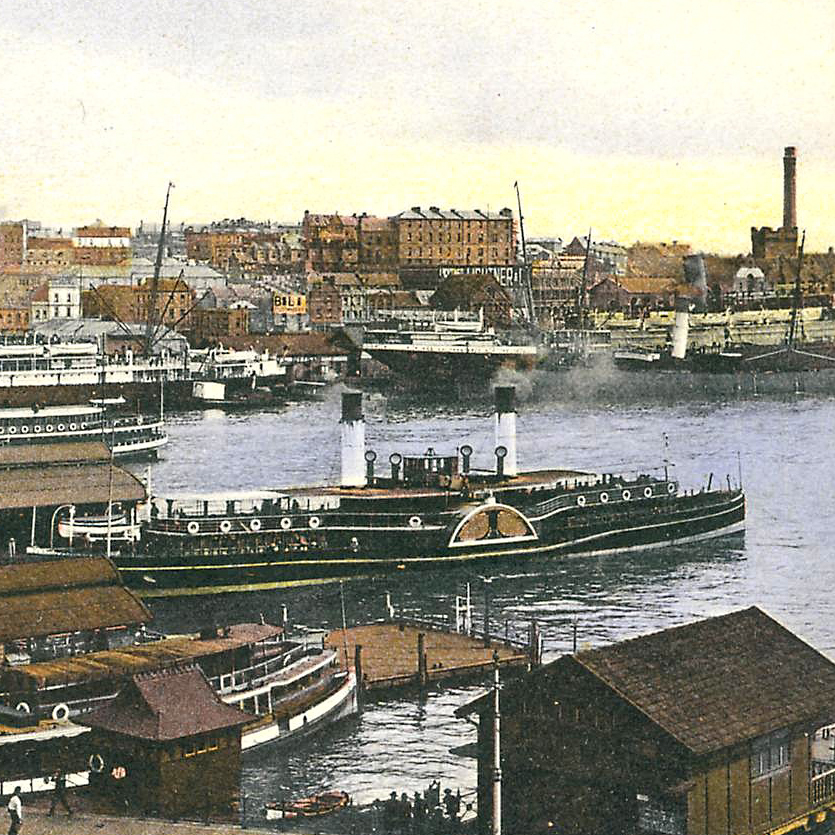Regular scheduled steam service to Manly began in 1855 following the construction of a wharf on the southern edge of Gayamay, or Manly Cove, serving mostly pleasure-seekers and daytrippers.
As the route developed, the vessels serving it varied from the rudimentary to the glamorous. PS Phantom had only a canvas awning to protect passengers from the elements and was known to have its boiler fires extinguished by the waves. Though fast and powerful, the small boat was notoriously unstable when crossing the Heads, where Sydney Harbour faces to the open sea. On the other hand, the paddle steamer Brighton, introduced to service in 1882, was extravagantly trimmed, replete with green velvet sofas, silk curtains, and stained-glass panels.
Expensive ticket prices, along with the unviability of the overland route in a time before private cars, entrenched Manly’s status as a posh resort ‘a thousand miles from care’. It took decades of jostling between the local council and ferry operators — mostly different iterations of the Port Jackson Company — to establish cheap fares and an expansive timetable. The result was a much loved and much used service, which solidified Manly’s popularity and strengthened its ties to the city’s centre.
As private car use took off after the second world war, and state planners prioritised different modes of transport, the service fell into decline. With the service’s private operator intent on closing the service, the Liberal State Government stepped in, taking ownership of the fleet in 1974.
Two years later, the new Labor State Government dramatically expanded state commitment to the fleet, laying plans for newer, larger vessels and reducing fares. By 1982, MV Freshwater had come off the slips of the NSW State Dockyard in Newcastle. Over the next six years it would be followed by MV Collaroy, MV Narrabeen, MV Queenscliff, the latter two built at the Carrington Slipways in Tomago.
The new ships were big: 70.4 metres long and 12.3 metres wide. They had a capacity for more than a thousand passengers, with two hydraulic gangway ramps on both passenger decks allowing for quick embarkation and disembarkation at dock. With a steel hull and raked aluminium superstructure, the Freshwaters were rugged as well — well suited to work the same choppy seas that had put out the engines of PS Phantom a century before.
 Passengers disembark at Manly Wharf in 1895. Photo: Graeme Andrews. Courtesy City of Sydney Archives.
Passengers disembark at Manly Wharf in 1895. Photo: Graeme Andrews. Courtesy City of Sydney Archives.
Paddle steamer Brighton at Circular Quay in the early 20th century. Photo: Graeme Andrews. Courtesy City of Sydney Archives.

MV Freshwater launching, aluminium superstructure not yet painted. Photo: Graeme Andrews. Courtesy City of Sydney Archives.

Bingarra-class MV North Head passing its successor, either MV Freshwater or Queenscliff. Photo: John Ward. Courtesy City of Sydney Archives.

MV Freshwater under construction in 1981. Photo: Graeme Andrews. Courtesy City of Sydney Archives.

MV Queenscliff docked at Circular Quay in 1993. Photo: Tim Cole. Courtesy City of Sydney Archives.

MV Queenscliff arriving in Manly in its blue and white livery. Photo: John Ward. Courtesy City of Sydney Archives.

MV Narrabeen bound for Manly in 2014. Photo: John Ward. Courtesy City of Sydney Archives.
We acknowledge the Gadi and Gayamay peoples, the Traditional Custodians of the lands between which the Freshwater ferries have historically sailed. We recognise their continuing connection to land and water, the sovereignty of which was never ceded.